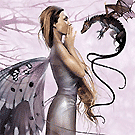 Igor Moiseyev, the founder of the Moiseyev Dance Company, at a rehearsal in 1986.
Igor Moiseyev, the founder of the Moiseyev Dance Company, at a rehearsal in 1986.
By JACK ANDERSON
Igor Moiseyev, the master choreographer who created a new form of theatrical folk dance in Russia and whose troupe was one of the most popular dance companies of the 20th century, died yesterday in Moscow. He was 101.  Alexander Zemlianichenko/Associated Press
Alexander Zemlianichenko/Associated Press
Igor Moiseyev, a Russian choreographer, in 2006.

Daniel Mihailescu/Agence France-Presse — Getty Images
The company in performance in 2003.
His death, at a hospital where he had been unconscious for three days, was announced by the troupe’s director, Yelena Shcherbakova, the ITAR-Tass news agency reported. The Kremlin said that President Vladimir V. Putin expressed condolences.
The Moiseyev Dance Company’s energy, virtuosity, precision and ingenious distillation of folk styles from many lands set audiences cheering worldwide. When the troupe made its New York debut in 1958, presented by the impresario Sol Hurok at the Metropolitan Opera House, it became the first major Soviet dance group to perform in the United States. The visit helped usher in a new era of cultural exchange, formalized that year by an agreement signed by the United States and the Soviet Union.
John Martin, the dance critic of The New York Times, pronounced the New York debut “stupendous.” And Ed Sullivan gave the troupe national exposure during the same trip, presenting the dancers for a full hour on his television variety show, “Toast of the Town” (later renamed “The Ed Sullivan Show”).
Although Mr. Moiseyev’s choreography derived from folk sources, he created his works for professional dancers: as observers noted from the start, no peasants or villagers ever danced with such theatrical flair.
“Moiseyev is an astute folklorist and a good artist,” Mr. Martin wrote in 1958. “His company, 100 strong, is warm, vital, vivacious, remarkably trained, energetic beyond belief, and above all performers deluxe.”
Igor Aleksandrovich Moiseyev (pronounced moy-SAY-yeff) was born in Kiev, Ukraine, in 1906, the only child of a Russian lawyer and a French-Romanian seamstress. His family lived in Paris until he was 8, and throughout his life he spoke to Western journalists in fluent French.
After the family returned to Russia he studied ballet privately in Moscow, then entered the Bolshoi Ballet School in 1921. From 1924 to 1939 he was a member of the Bolshoi, sympathetic to the efforts of innovative Soviet choreographers of the 1920s and ’30s.
He developed his own interest in choreography, and his early ballets — among them “The Footballer” (1930), “Salammbô” (1932) and “Three Fat Men” (1935) — were noted for their experimentation, drama and characterization.
In 1936 Mr. Moiseyev was appointed dance director of the Moscow Theater of Folk Art, from which emerged, a year later, the Soviet Union’s first folk-dance ensemble. The troupe originally included many amateurs, but it soon employed professionally trained dancers. Officially known as the State Academic Folk Dance Ensemble of the Soviet Union, the troupe was usually billed in the West simply as the Moiseyev Dance Company.
Most of Mr. Moiseyev’s works were inspired by the traditions of the various regions in the Soviet Union. But he also created dances with Chinese, Cuban, Sicilian and Argentine themes, and in the early ’60s his dancers amused American audiences by performing the Virginia reel and a parody of rock ’n’ roll.
Mr. Moiseyev attributed his dancers’ virtuosity and versatility to their training in classical ballet, which he described in a 1970 interview as “the grammar of movement.”
“With ballet technique as a base,” he added, “one can do everything.”
He continued to work with traditional ballet companies throughout his career. In 1958, he staged his own version of “Spartacus” for the Bolshoi Ballet.
In addition to directing his folk ensemble, from 1967 to 1971 he headed a classical ballet troupe. Among its members were Alexander Filipov and Alexander Godunov, who both later joined American Ballet Theater in New York.
It was always Mr. Moiseyev’s folk dances that brought him international attention and acclaim. A favorite with audiences everywhere was the dramatic “Partisans,” which was both a tribute to Soviet guerrilla fighters in World War II and a technical tour de force that required dancers to imitate the gait of mounted soldiers whose “horses” were invisible under their cloaks.
The Moiseyev company consistently received critical acclaim. Yet as its repertory became familiar, the pioneering dancers of the original troupe were replaced by younger performers more concerned with technique than with motivating impulse. Reviewers began to notice limitations in the troupe’s aesthetic approach.
As a popular Soviet cultural export, the Moiseyev company was occasionally the target of American groups protesting Soviet policies. Most such demonstrations involved only picketing, but others turned violent. At a Moiseyev opening in September 1986, Russian members of the Jewish Defense League threw a tear gas canister into the audience at the Metropolitan Opera House, sending nearly 4,000 people streaming out of the hall.
Controversies also developed over the ideological content of Mr. Moiseyev’s work. Many Western critics found his happy folk to be in line with an accent on the positive required by Socialist Realism. A defender of expressive dramatic content in choreography, Mr. Moiseyev reiterated the dominant Soviet aesthetics of the cold war period when he deplored abstraction in ballet.
But Mr. Moiseyev, who refused to join the Communist Party, did more than parrot officially sanctioned views. In 1959 he was reprimanded by Soviet authorities for delivering a speech in which he maintained that American culture, far from being inherently decadent, was blessed with vigor. In 1967 he ruffled the Soviet authorities by asserting in a Pravda article that Soviet ballet was deadened by its preoccupation with princes and princesses and its unwillingness to tackle contemporary themes.
Mr. Moiseyev married the dancer Tamara Zeifert in 1940; she became his choreographic assistant. Other members of the company included their daughter, Olga Moiseyeva, and her husband, Boris Petrov. Mr. Moiseyev married a second time, and his wife is among his survivors, Ms. Shcherbakova said.
In poor health in recent years, he was rarely seen in public. But he appeared at a concert in Moscow last year to celebrate his 100th birthday. On his centenary, he received the Order of Merit, Russia’s highest civilian decoration. He had earlier been named People’s Artist of the U.S.S.R.. His other honors included the Dance Magazine Award in the United States, the Lenin Prize and three Stalin Prizes.
A creatively passionate man, Mr. Moiseyev said in a 1965 interview: “Everything I’ve done, I love. If you’re not in love, you can’t create. And if you’re calm when you’ve created something, you can rest assured that you’ve created nothing.”
More Articles in Arts » Published: November 3, 2007
Igor Moiseyev, a celebrated Russian choreographer who left the Bolshoi Ballet in 1937 to form a world-renowned folk ballet troupe, has died, the Agency for Culture and Cinema said Friday. He was 101.
 AFP/POOL/File Photo: Igor Moiseyev, a celebrated Russian choreographer seen here in in 2006 and who left the Bolshoi Ballet in 1937 to form a world-renowned folk ballet troupe, has died at the age of 101.(AFP/POOL/File)
AFP/POOL/File Photo: Igor Moiseyev, a celebrated Russian choreographer seen here in in 2006 and who left the Bolshoi Ballet in 1937 to form a world-renowned folk ballet troupe, has died at the age of 101.(AFP/POOL/File) Ballerina Ekaterina Berezina (R) of Moscow's Classical Ballet company performs during their dress rehearsal of "Cinderella" in Madrid October 30, 2007. REUTERS/Andrea Comas (SPAIN)
Ballerina Ekaterina Berezina (R) of Moscow's Classical Ballet company performs during their dress rehearsal of "Cinderella" in Madrid October 30, 2007. REUTERS/Andrea Comas (SPAIN)


 Ballet dancers Ekaterina Berezina (L), Alexey Orlov (C) and Daria Liakisheva of Moscow's Classical Ballet company perform during their dress rehearsal of "Cinderella" in Madrid October 30, 2007. REUTERS/Andrea Comas (SPAIN)
Ballet dancers Ekaterina Berezina (L), Alexey Orlov (C) and Daria Liakisheva of Moscow's Classical Ballet company perform during their dress rehearsal of "Cinderella" in Madrid October 30, 2007. REUTERS/Andrea Comas (SPAIN)
President Vladimir Putin on Friday offered his condolences to relatives and friends of Moiseyev, who continued to direct his troupe until shortly before his death.
"Moiseyev played an exceptional role in world dance," former Bolshoi star Lyudmila Semenyaka told Interfax news agency on Friday. "He took folk dance to an incredible height, creating a new form of choreography," she said. "Today's tragic news has shaken me."
Born in Kiev on January 21, 1906, he formed the "Moiseyev Ballet" in Moscow at the height of Stalin's purges after several years dancing for the Bolshoi, the country's top ballet company.
His idea of forming a school to focus on the national dances of the Soviet Union received the personal approval of Soviet prime minister Vyacheslav Molotov.
Moiseyev travelled across the Soviet Union, from the Caucasus to the Ural Mountains, collecting material for his repertoire.
A disciple of the avant-garde choreographer Kasyan Goleizovsky, Moiseyev transformed the dances, infusing them with classical ballet techniques.
"His greatest achievement was forming a genre in which he synthesized the classical choreography of the Bolshoi Theatre... with elements of folk dance," Russia's minister for culture, Alexander Sokolov said Friday, RIA Novosti reported.
During World War II the troupe toured the country, performing for soldiers, workers and the infirm, according to a biography posted on the troupe's web site.
Later touring extensively in the West, the troupe's dancers became famous for kicks and acrobatic jumps inspired by the Caucasus mountains dances and the Cossacks.
Moiseyev earnt an exalted place for himself in Moscow's cultural hierarchy that he managed to retain after the collapse of the Soviet Union in 1991.
A memorial service will be held on Wednesday at Moscow's Chaikovsky Concert Hall, an official at the Moiseyev Ballet told Interfax on Friday. Fri Nov 2, 3:28 PM ET
Labels: Death, dedication, history, Obituary

 Flooded
Flooded


 Igor Moiseyev, the founder of the Moiseyev Dance Company, at a rehearsal in 1986.
Igor Moiseyev, the founder of the Moiseyev Dance Company, at a rehearsal in 1986.  Alexander Zemlianichenko/Associated Press
Alexander Zemlianichenko/Associated Press
 AFP/POOL/File Photo: Igor Moiseyev, a celebrated Russian choreographer seen here in in 2006 and who left the Bolshoi Ballet in 1937 to form a world-renowned folk ballet troupe, has died at the age of 101.(AFP/POOL/File)
AFP/POOL/File Photo: Igor Moiseyev, a celebrated Russian choreographer seen here in in 2006 and who left the Bolshoi Ballet in 1937 to form a world-renowned folk ballet troupe, has died at the age of 101.(AFP/POOL/File) Ballerina Ekaterina Berezina (R) of Moscow's Classical Ballet company performs during their dress rehearsal of "Cinderella" in Madrid October 30, 2007. REUTERS/Andrea Comas (SPAIN)
Ballerina Ekaterina Berezina (R) of Moscow's Classical Ballet company performs during their dress rehearsal of "Cinderella" in Madrid October 30, 2007. REUTERS/Andrea Comas (SPAIN)

 Ballet dancers Ekaterina Berezina (L), Alexey Orlov (C) and Daria Liakisheva of Moscow's Classical Ballet company perform during their dress rehearsal of "Cinderella" in Madrid October 30, 2007. REUTERS/Andrea Comas (SPAIN)
Ballet dancers Ekaterina Berezina (L), Alexey Orlov (C) and Daria Liakisheva of Moscow's Classical Ballet company perform during their dress rehearsal of "Cinderella" in Madrid October 30, 2007. REUTERS/Andrea Comas (SPAIN) 















 A man swims in flood waters in Villahermosa in Mexico's Gulf coast. Hundreds of thousands of Mexicans fled a flooded region of the Gulf coast Friday, jumping from rooftops into rescue helicopters, scrambling into boats or swimming out through murky brown water, while Mexico's President Felipe Calderon called it one of Mexico's worst recent natural disasters.
A man swims in flood waters in Villahermosa in Mexico's Gulf coast. Hundreds of thousands of Mexicans fled a flooded region of the Gulf coast Friday, jumping from rooftops into rescue helicopters, scrambling into boats or swimming out through murky brown water, while Mexico's President Felipe Calderon called it one of Mexico's worst recent natural disasters.















